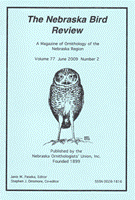Nebraska Ornithologists' Union

Nebraska Bird Review
Date of this Version
6-2013
Document Type
Article
Citation
Mollhoff, “Status of Black-billed Magpie in Nebraska,” from Nebraska Bird Review (June 2013) 81(2).
Abstract
Black-billed Magpie is currently listed as a species of least concern by the International Union for Conservation of Nature (IUCN); however, it has been in abrupt decline in Nebraska with no evidence that it is beginning to recover. There appear to be at least two causes for this decline. The initial decline began at the end of the first atlas project and went unnoticed at the time. It began after the introduction of famphur (also known by its trade name Warbex), an insecticide introduced to control parasitic warble flies (Hypoderma sp.) in cattle. Die-offs of both magpies and hawks were soon documented (Henny et al. 1985). The impact on magpies in the state was probably gradual at first. The second decline began in 2002 with the arrival of the mosquito-borne West Nile virus. It hit the Corvidae family (crows, jays & magpies) especially hard. The magpies in Nebraska currently appear to be broken up into isolated pockets and susceptible to all the usual factors that contribute to extinction of such pockets: lack of gene flow, inbreeding, local weather or habitat disasters, etc. (Quammen 1996). Historically, the species was found across much of the state, but declined with the advance of European settlement until it was found only in western Nebraska (Bruner et al. 1904). It gradually recovered and spread eastward to reoccupy its former range by the time of the first atlas project (Mollhoff 2001). Whether, or how soon, it can recover from the current threats remains to be seen.


Comments
Copyright 2013 Nebraska Ornithologists' Union. Used by permission.